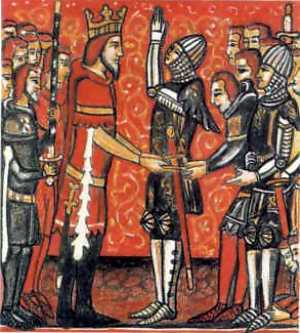Feudalism vs Manorialism
Feudalism and Manorialism are two systems that displayed differences between them in terms of concept and understanding. The manorial system focused on the organization of agricultural and craft production, while feudalism describes the legal obligation of vassals to nobles. These distinctions are key between the two systems of thought. Both systems were in practice during the Middle Ages, and were solutions to the numerous invasions Europe experienced during that time. Feudalism and manorialism ensured the country was safe and self-sufficient.
What is Feudalism?
Feudalism is a political system, based on the defense of the kingdom. During the Middle Ages, kings were not very powerful due to numerous invasions and had difficulty defending their territory effectively. As a solution, the king, as the owner of all the lands, divided those lands and gave them to nobles, who were the high-class just below the monarchy in a kingdom. Once they obtained the land, they distributed it among vassals, who were low-ranking lords of society. In return for the land given to them, vassals pledged their loyalty to the nobles and provided military support in times of need. The estates given to vassals were known as fiefs. Feudalism was legal in character, supporting legal, cultural, and political ramifications at the highest levels while dealing with the relationship between the Lord and Vassal. Feudalism had to do with the relationship between men of power, starting from the monarch, or the king, at the top to the knight, to the manor at the bottom.
What is Manorialism?
Manorialism focused on making the kingdom self-sufficient. Once the land was divided between the vassals or the knights, the lords allowed peasants to come and live on a plot of land and farm or engage in whatever industry they followed. In return for living on the land that belonged to the lord, peasants served the lord by providing him with products, attending to him in his households, and doing whatever the lord wanted. These peasants who lived in these plots of lands are known as serfs. The entire area of land that belonged to this particular vassal revolved around the manor of the Lord, giving rise to the term manorialism. Manorialism was economic in character, as it was an economic system. The system of Manorialism survived at the individual level and was alternatively called Seigneurialism. It discussed the society in medieval Western Europe and parts of central Europe and the organization of the rural economy. A knight was in charge in the manorial system, and he occupied the state or plantation. Manorialism dealt with the relationship between the serf and the Lord.
What is the difference between Feudalism and Manorialism?
Feudalism and manorialism are both offshoots of medieval life. The main differences between them include:
Key Takeaways
- Concept: Feudalism describes the legal obligation of Vassal to nobles, while the manorial system concentrates on the organization of agricultural and craft production.
- Nature: Feudalism is legal in character, while manorialism is economic in character.
- Relationship: Feudalism deals with the relationship between nobles and vassals, while manorialism deals with the relationship between the vassals, or the lords, and the peasants or serfs.
Feudalism is a political system, while manorialism is an economic system. Feudalism comes with a military obligation, meaning the vassal has an obligation to provide military support. Manorialism, on the other hand, does not come with a military obligation. The serfs are only expected to serve the lord, and the lord has to protect the serf. Manorialism is contained in Feudalism in the sense that Feudalism deals with multiple manors and the relationship between landlords. Description of one landlord is manorialism, whereas the description of many manors is feudalism. As can be seen, both feudalism and manorialism were created to protect the kingdoms during the Middle Ages.
